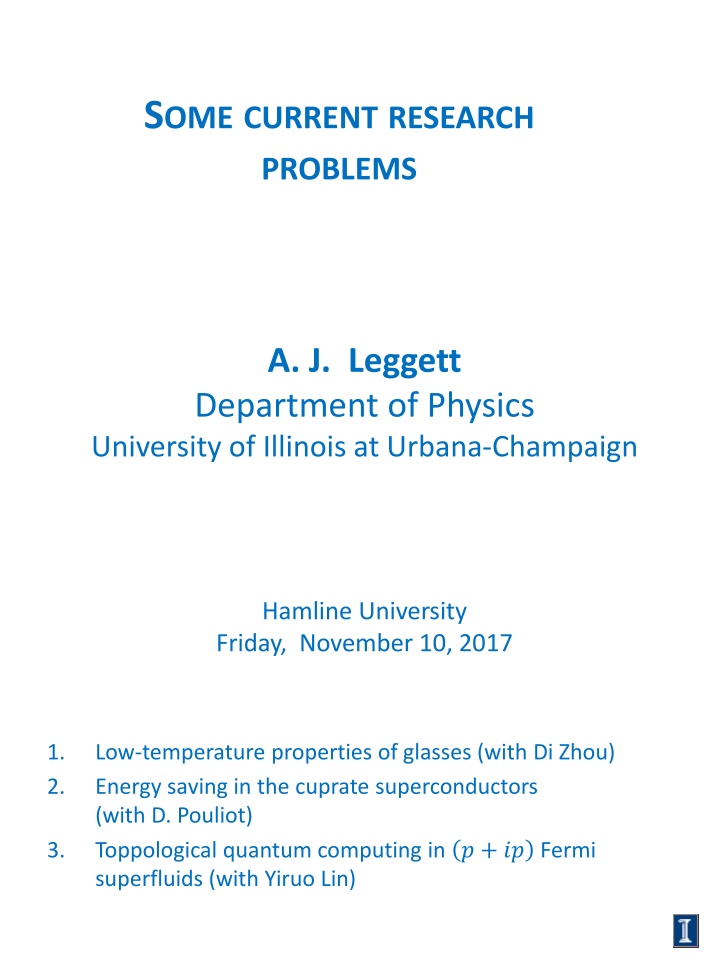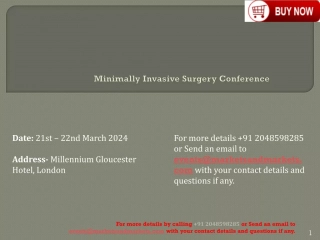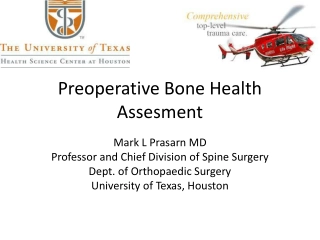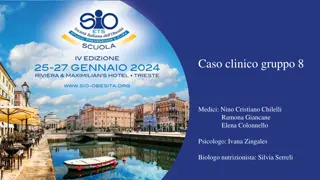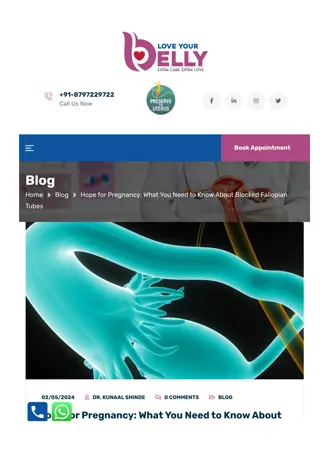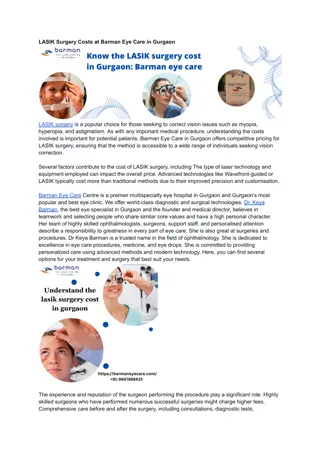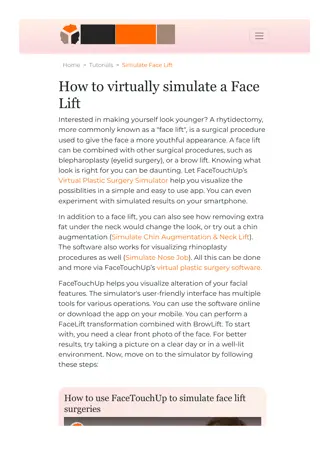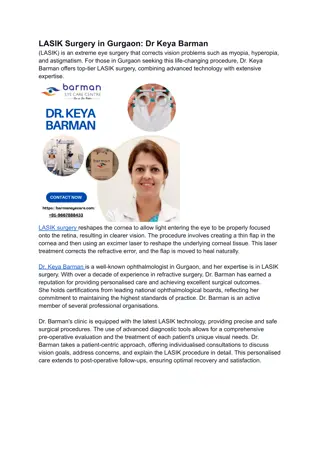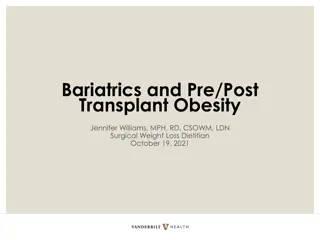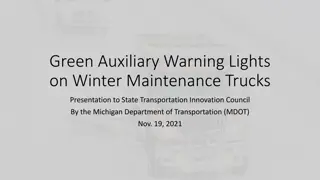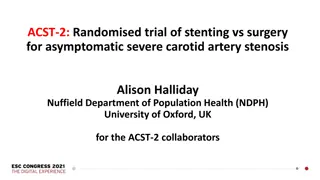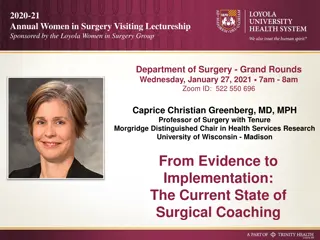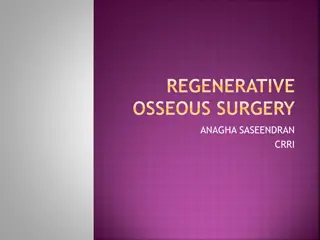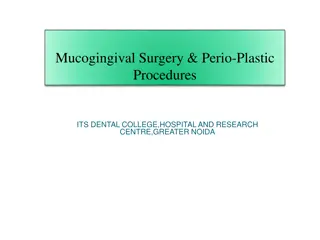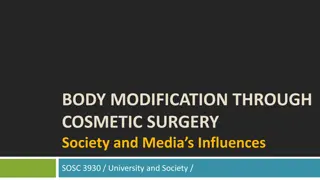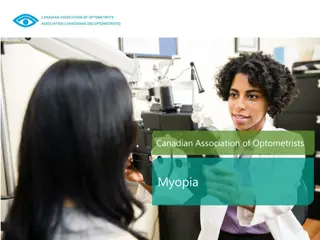Glare Associated with LASIK Surgery
Glare is a common issue after LASIK surgery that can affect visual acuity. This presentation discusses the impact of asking about glare on self-reports post-LASIK surgery and shares insights into the discomfort and disability associated with glare. The study highlights the importance of understanding patient perspectives on post-surgical symptoms to enhance patient care.
Download Presentation

Please find below an Image/Link to download the presentation.
The content on the website is provided AS IS for your information and personal use only. It may not be sold, licensed, or shared on other websites without obtaining consent from the author.If you encounter any issues during the download, it is possible that the publisher has removed the file from their server.
You are allowed to download the files provided on this website for personal or commercial use, subject to the condition that they are used lawfully. All files are the property of their respective owners.
The content on the website is provided AS IS for your information and personal use only. It may not be sold, licensed, or shared on other websites without obtaining consent from the author.
E N D
Presentation Transcript
SOMECURRENTRESEARCH PROBLEMS A. J. Leggett Department of Physics University of Illinois at Urbana-Champaign Hamline University Friday, November 10, 2017 1. 2. Low-temperature properties of glasses (with Di Zhou) Energy saving in the cuprate superconductors (with D. Pouliot) Toppological quantum computing in ? + ?? Fermi superfluids (with Yiruo Lin) 3.
Mm- 1 1. LOWTEMPERATURE ( 1K) PROPERTIESOFGLASSES Crystals (the anomaly) Glasses (the norm) Specific heat ?? ?3 ? (roughly) ?2 (roughly) Thermal conductivity ?????/? Yes Saturation of sound absorption? No Yes Echoes in sound absorption? No etc A bet: Measure Predict ? 1= 3 10 4 Dimensionless transverse ultrasonic absorption ? 1(MHz-GHz) 50% not crystalline, not metallic verified: ~30 different materials falsified ~1-2
Mm- 2 WHY? Standard model of LT properties of glasses: tunnelling two-level systems ( TTLS ) crystal glass ? with suitable choice of parameters, can explain ??,?, echoes --- : in TTLS model, ultrasound absorption ? 1 is product of 3 independent factors: density of TTLS states ? ? ?2 ??2 ? 1=? 2 coupling of sound to TTLS states compressibility These 3 factors are mutually independent! So how come they always conspire to give ? 1 3 10 4?
Mm- 3 LT PROPERTIESOFGLASSES: THE COLLECTIVE SCENARIO At microscale ( 20 , say) excitations are (1) Phonons (harmonic oscillators) (2) Something else ( junk ) 1 The junk can be anything except harmonic oscillators. 3, say). The junk 2 Now consider small block (size ~ 100 contributes to the (non-phonon) stress tensor of the block, which will interact with the phonon degrees of freedom s.t. 100 . block ???? ? interaction = ??? superblock ? 3 As a result, one gets an interaction between stress tensors of neighboring blocks: ?? ? ???? ?superblock ??+ ????? ??? ? ?? 1 where????? ?? ?? nasty 4th rank tensor = 3 ???? ?? ?? ? and ? generated for superblock repeat process (real-space RG). Crucial point: because of ? 3 behavior of interaction, problem looks identical at each scale one might anticipate properties iterate to a fixed point. Quantization implementation: very hard! 50 years partial success, still trying
Mm- 4 2. Energy Saving in Cuprate Superconductivity Quite generally, if a system makes a transition from a disordered state to a more ordered one as ? decreases towards 0, can conclude that at ? = 0?ord< ?dis. So in particular, if a metal makes a transition from normal (?) state to superconducting (?) state as ? 0, then at ? = 0??< ??. So: Where does the energy saving come from? (a) Classic superconductors (Al, Sn, Nb ): standard textbook picture: (from isotope effect) +v? ions drawn towards path of ?1 towards past position of ?1 retarded ? ? attraction, may outweigh direct Coulomb repulsion. (Some of) this attraction then saved when ? s form Cooper pairs. + + + + , relax slowly ?2 attracted ?2 + + + + + + + + ?1 + + + + Chester (1956): saved total Coulomb energy ? ?,? ?,? ? exactly balanced by expenditure of electronic kinetic energy. Balance is tipped by nuclear kinetic energy!
Mm- 5 (b) Cuprate superconductors (since 1986): lack of isotope effect, etc. ionic motion (phonons) unimportant. Then only remaining energies which might be saved are (a) electron kinetic energy and (b) inter-electron Coulomb repulsion. Default assumption is latter, then: ?total= ?3? ?? ? ?? , Dielectric constant, measurable in experiments ? ?? = ?? 1/? ?? loss function Where in space of wave vector ? and frequency ? is Coulomb energy saved? Use Willie Sutten principle : ??1/? ? ? |?? Conjecture small ???, midinfrared ?! In principle, verifiable by EELS experiments (e.g. P. Abbamonte, UIUC) or (less unambiguously) optics (e.g. D. van der Marel (Geneva))
Mm- 6 3. Topological Quantum Computing Currently, there is a huge interest in the possibility of building a quantum computer, which (theoretically) might be able to perform in a few minutes calculations which would take a classical computer the age of the universe. The underlying principle is that while the basic element of a classical computer, a bit , can only take one of the 2 values 0 or 1, the corresponding element in a quantum computer (sometimes called a qubit ) can exist in an arbitrary quantum superposition of the two quantum states | 0 ,| 1 corresponding to the classical 0(1): | ? = ?| 0 + ?| ?,? complex numbers, ?2+ ?2= 1 1 This might not look like a dramatic advantage for a single qubit, but for N qubits it has the effect of replacing 2N variables by 2N variables, permitting massive parallel processing which the quantum computer is designed to carry out. If it is to do so successfully, we must be able (as a minimum) to (a) change the values of ? and ? at will when we want to (b) preserve the values of ? and ? when we do not want to affect them Both of these operations are subject to random interference by the environment of the system, which in particular is likely to scramble the relative phase and magnitude of ? and ? in a random way, ( decoherence ) so to build a working quantum computer we have to fight this tendency (point (b)) while at the same time being able to manipulate the relative phase and amplitude when we want to (point (a)). In other words, we should be able to do something Nature can t. Example: trapped ions (we have laser, Nature doesn t!)
Mm- 7 The principle involved in topological quantum computing (TQC) is to choose the states | 0 and | 1 to be very complicated states of a many-particle system, so that the phase and amplitude information is topologically protected and can be recovered only by some complicated operation which is available to us but not to nature. One kind of system which is believed to be suitable for TQC is a topological superconductor such as Sr2RuO4. Superconductivity occurs when the system forms Cooper pairs, but these may have different symmetries (relative wave function): classic superconductors (e.g. Al, Sn, Pb ) s-wave (boring) high-temperature superconductors (e.g. YBCO) topological superconductors (Sr2RuO4) d-wave (somewhat more interesting) ? + ?? very interesting In a ? + ?? superconductor, it is possible to produce a peculiar kind of vortex, which comes in pairs. Given such a pair, it is believed that we can associate with them 2 states | follows: In state | 0 , nothing sits on either vortex: total number of particles in system is even. 0 and | 1 , as In state | between the two vortices (even if they are a mile apart!): total number of particles is odd. Often this Bogoliubov quasiparticle is said to split itself into 2 independent Majorana fermions. (much sought after in experiment) 1 , a single extra Bogoliubov quasiparticle is shared
Mm- 8 The standard picture relaxes condition of conservation of particle number, and postulates that the extra particle is a quantum superposition of an extra electron and an extra hole. Since these have equal weight, on average there is no extra mass or charge density, so this extra particle (or the individual Majorana fermions) is completely undetectable by any local probe. Moreover, (it is claimed ) if one constructs the quantum superposition | 0 + ?| 1and then braids (interchanges) the vortices, the relative phase of and ? changes by nonabelian ( Ising ) statistics and hence the possibility of topologically protected quantum computing. ? 2, implying : standard lore relies on mean-field approach, which violates conservation of particle number. In reality, when one creates the hole component of | Cooper pair is conserve particle number. 1 , one has to add an extra The $64K question: Is this extra Cooper pair harmless , or does it spoil the whole show?
